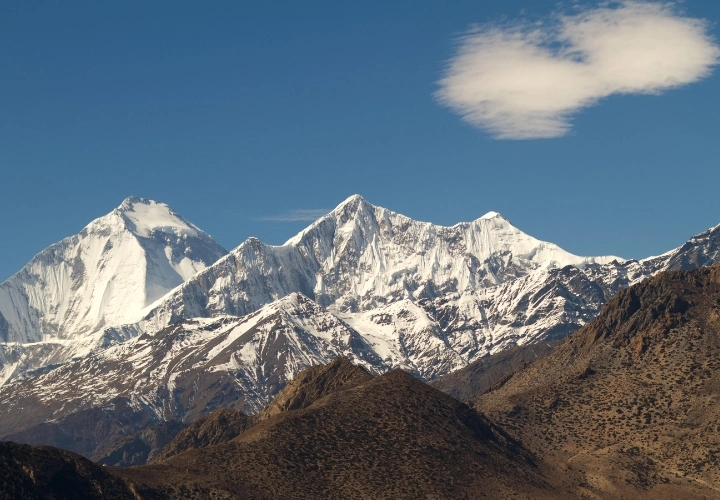Nepal vision | 13/06/2024
The next destination in your trekking adventure is the Kanchenjunga Base Camp Trek, an unexplored gem located in the heart of the Kanchenjunga ranges in the eastern region of Nepal.
But wait, what about the difficulty of the trail? The trek takes you through the remote region of Kanchenjunga, so many of you might think it could be hard.
Stay with us as we clear all your doubts about the Kanchenjunga Trek difficulty.
Overview of Kanchenjunga Base Cam Trek
The Kanchenjunga Base Camp Trek is located on the lap of the Kanchenjunga mountain, which has a blend of breathtaking natural beauty and rich cultural heritage. You'll gaze upon the majestic Kanchenjunga massif, including peaks like Tent Peak and Nepal Peak, as well as the impressive southwest face of Kanchenjunga itself.
Along the way, discover diverse wildlife, such as snow leopards and red pandas, in the untouched landscapes of the Kanchenjunga Conservation Area. This route provides a challenging yet rewarding journey through high-altitude terrains and remote villages.
Moreover, after traversing several suspension bridges, the trail will lead you to the northern base camp of Kanchenjunga, the third-highest mountain in the world at 8,586 meters. The area is inhabited by diverse local communities, such as Sherpas, Rais, and Limbus, each with their unique traditions and cultural practices that add a fascinating layer to the trekking experience.
Similarly, the Kanchenjunga extreme trek has even more to offer for adventurer loving trekkers.
Factors Affecting the Difficulty of the Trek
Several factors influence the difficulty of the Kanchenjunga Base Camp trek. The trek takes you through high-altitude and mountainous regions, which affects the difficulty of the trail. Let's break down the factors that contribute to the difficulty of the trek.
Elevation
Trekking at altitudes nearing 5,000 meters has significant challenges due to reduced oxygen levels. The lower oxygen level can trigger altitude sickness. Symptoms include headaches, nausea, and fatigue, requiring proper acclimatization.
Adequate acclimatization becomes crucial at key elevations such as Taplejung, Ghunsa, and Sele La Pass. This involves gradual ascent, hydration, and rest to allow the body to adjust to higher altitudes safely.
Terrain and Distance
The trek involves navigating through rough, hilly terrain with steep ascents and descents. This terrain can be physically demanding and requires good fitness levels and endurance.
Covering 8-12 kilometers per day with 6-7 hours of walking means a moderate pace suitable for the terrain and altitude challenges.
Challenges like river crossings, narrow cliffs, and rocky paths add to the difficulty and require careful navigation and possibly additional skills.
Seasonal Impacts on Trek Difficulty
- Spring and Autumn: These seasons are optimal for trekking due to their stable and clear weather conditions. Trails are generally easier to navigate, and the temperatures are comfortable for trekking.
- Summer: Heavy rainfall during the monsoon season increases the difficulty of the trek. Muddy and slippery trails can make progress slow and dangerous and require careful consideration possibly affecting trekking plans.
- Winter: Cold temperatures and potential snowfall make winter trekking more challenging, requiring adequate cold-weather gear and experience with high-altitude conditions.

What is the physical fitness required for the Kanchenjunga Base Camp Trek?
Physical fitness is crucial for the Kanchenjunga Base Camp trek due to the challenging terrain, high altitudes, and potential weather conditions. But how can you maintain your fitness? Let us find out.
- Cardiovascular Endurance: The trek involves long days of walking, often 6-7 hours a day, covering 8-12 kilometers (5-7 miles) on rough and hilly terrain. Building cardiovascular endurance through activities like hiking, running, cycling, or swimming is beneficial.
- Strength and Muscle Endurance: Strengthening leg muscles, core muscles, and upper body (for carrying a backpack) is important. Exercises like squats, lunges, planks, and upper body exercises (push-ups, shoulder presses) help build the necessary strength.
- Flexibility and Balance: Flexibility exercises like yoga or stretching routines improve joint mobility and reduce the risk of injuries. Balance exercises, such as standing on one leg or using a balance board, can enhance stability on uneven terrain.
- Mental Preparation: Trekking at high altitudes and through challenging terrain requires mental resilience. Practicing mindfulness, meditation, or other stress-reducing techniques can help manage the physical and mental challenges of the trek.
Tips to Tackle the Difficulty of the Trek
- Acclimatize Properly: To reduce the risk of altitude sickness, take sufficient time to acclimatize at higher altitudes. Gradual ascent, staying hydrated, and paying attention to your body’s signals are crucial.
- Pace Yourself: Maintain a steady pace throughout the trek to conserve energy and avoid exhaustion. Start early in the day to take advantage of cooler temperatures and allow plenty of time for rest breaks.
- Stay Hydrated and Nourished: Drink plenty of water to stay hydrated, even if you don't feel thirsty due to the dry air and exertion. Carry high-energy snacks like nuts, dried fruits, and energy bars to maintain energy levels throughout the day.
- Be Weather-Ready: Pack appropriate clothing layers for varying weather conditions, including rain gear for potential monsoon rains or sudden changes in weather. Dressing in moisture-wicking fabrics and carrying extra warm layers for colder temperatures at higher altitudes is essential.
- Listen to Your Body: Pay attention to any signs of fatigue, altitude sickness symptoms, or discomfort. Communicate openly with your trekking companions and guides about how you're feeling. It's better to take breaks or adjust your pace than to push yourself beyond your limits.
To wrap it up, The Kanchenjunga Base Camp trek offers a challenging yet rewarding adventure in the Himalayas. Prioritize fitness, acclimatization, and weather readiness to navigate safely through rugged terrain and high altitudes.
Make your trekking journey magical then with Nepal Vision Trek. From iconic Himalayan treks to personalized itineraries, our experienced guides ensure an unforgettable journey.
FAQS









